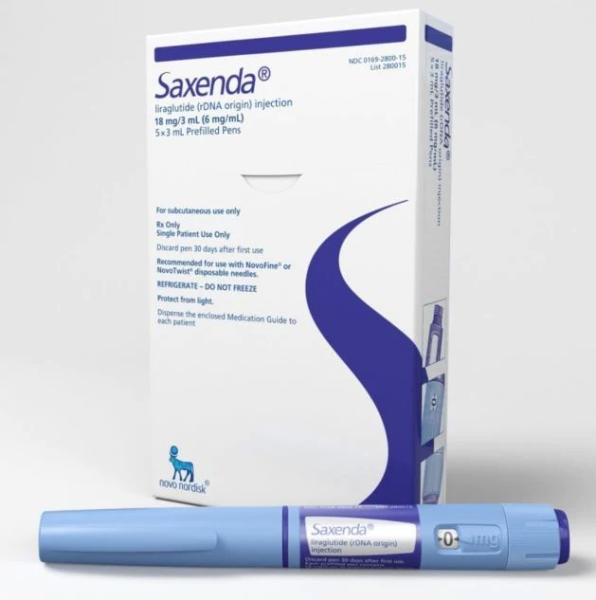Saxenda Dosage
Generic name: LIRAGLUTIDE 6mg in 1mL
Dosage form: injection, solution
Drug class: GLP-1 Agonists (Incretin Mimetics)
Medically reviewed by Drugs.com. Last updated on May 1, 2025.
Important Administration Instructions
- •
- Prior to initiation of SAXENDA, train patients on proper injection technique. Refer to the accompanying Instructions for Use for complete administration instructions with illustrations.
- •
- Inspect SAXENDA visually prior to each injection. Only use if solution is clear, colorless, and contains no particles.
- •
- Administer SAXENDA in combination with a reduced-calorie diet and increased physical activity.
- •
- Inject SAXENDA subcutaneously once daily at any time of day, without regard to the timing of meals.
- •
- Inject SAXENDA subcutaneously in the abdomen, thigh, or upper arm. No dosage adjustment is needed if changing the injection site and/or timing.
- •
- Rotate injection sites within the same region in order to reduce the risk of cutaneous amyloidosis.
- •
- If a dose is missed, resume the once-daily regimen as prescribed with the next scheduled dose. Do not administer an extra dose or increase the dose to make up for the missed dose.
- •
- If more than 3 days have elapsed since the last SAXENDA dosage, reinitiate SAXENDA at 0.6 mg daily and follow the dosage escalation schedule in Table 1, to reduce the risk of gastrointestinal adverse reactions associated with reinitiation of treatment.
Dosage in Adults and Pediatric Patients Aged 12 Years and Older
- •
- Initiate SAXENDA with a dose of 0.6 mg daily for one week. Then follow the dosage escalation schedule in Table 1 to reduce the risk of gastrointestinal adverse reactions.
Table 1. Dose Escalation Schedule
|
Week |
Daily Dose |
|
1 |
0.6 mg |
|
2 |
1.2 mg |
|
3 |
1.8 mg |
|
4 |
2.4 mg |
|
5 and onward |
3 mg |
- Adult Patients
- •
- For adults, the recommended dosage of SAXENDA is 3 mg daily, lower dosages are for titration only.
- •
- Discontinue SAXENDA if the patient cannot tolerate the 3 mg dosage.
- •
- If patients do not tolerate an increased dose during dosage escalation, consider delaying dosage escalation for approximately one additional week.
- •
- Evaluate the change in body weight 16 weeks after initiating SAXENDA and discontinue SAXENDA if the patient has not lost at least 4% of baseline body weight, since it is unlikely that the patient will achieve and sustain clinically meaningful weight loss with continued treatment.
- •
- In adult patients with type 2 diabetes, monitor blood glucose prior to starting SAXENDA and during SAXENDA treatment.
Pediatric Patients
- •
- For pediatric patients, the recommended maintenance dosage of SAXENDA is 3 mg daily. Pediatric patients who do not tolerate 3 mg daily may have their maintenance dose reduced to 2.4 mg daily. Discontinue SAXENDA if the patient cannot tolerate the 2.4 mg dose.
- •
- If pediatric patients do not tolerate an increased dose during dosage escalation, the dose may also be lowered to the previous level. Dosage escalation for pediatric patients may take up to 8 weeks.
- •
- Evaluate the change in BMI after 12 weeks on the maintenance dose and discontinue SAXENDA if the patient has not had a reduction in BMI of at least 1% from baseline, since it is unlikely that the patient will achieve and sustain clinically meaningful weight loss with continued treatment.
Frequently asked questions
- Which GLP-1 drug is best for weight loss?
- Saxenda vs Ozempic: For Weight Loss?
- Why am I not losing weight on Saxenda?
- What foods should I avoid while on Saxenda?
- Saxenda vs Wegovy: Which weight loss drug is right for you?
- How and where do you inject liraglutide?
- Can liraglutide be used for weight loss?
More about Saxenda (liraglutide)
- Check interactions
- Compare alternatives
- Pricing & coupons
- Reviews (1,451)
- Drug images
- Latest FDA alerts (3)
- Side effects
- During pregnancy
- Support group
- FDA approval history
- Drug class: GLP-1 Agonists (Incretin Mimetics)
- Breastfeeding
- En español
Patient resources
Other brands
Professional resources
Other brands
Related treatment guides
See also:
Further information
Always consult your healthcare provider to ensure the information displayed on this page applies to your personal circumstances.


